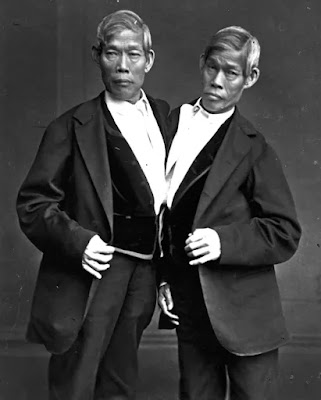Another Monday, another moment from history! This week is about the original conjoined twin brothers, Chang and Eng Bunker and how they died. These are the brothers who coined "Siamese twins". I loved researching the Bunker twins. They are definitely the most interesting subjects of this series so far and I highly recommend doing your own research about them!
 |
| (L-R) Eng and Chang Bunker |
Let's start at the beginning. Chang and Eng Bunker were born in 1811, but the exact date is unknown. However, some records state their birthday to be May 11th. The brothers were born in Samut Songkhram in modern day Siam. Their father, Ti-eye is said to have died in their adolescence. Their mother, Nok allegedly said their birth was no different than any of her other children.
The brothers were conjoined at the sternum by a band of flesh and cartilage that was about 5in. long. Their livers were also connected through the band.
The twins were "discovered" in 1824 by a merchant named Robert Hunter. Robert claims the king of Siam at the time refused to let him leave the country with them and ordered the death of Chang and Eng. He was able to bring the twins to the United States in 1829 when they were 17. They were exhibited as a "freak show".
They are most most known for being exhibited by P.T. Barnum in Barnum's American Museum and it's popularly believed that Barnum had helped them find fame, but they did not begin working with Barnum until October of 1860. So they had already been touring the world as a "freak show" for 31 years.
 |
| (L-R) Sarah, Eng and their son, Patrick Henry; Chang, Adelaide and their son, Albert |
The brothers married a pair of sisters, Adelaide (married to Chang) and Sarah (married to Eng) Yates in 1843. Between the two brothers, they had twenty-one children, Chang had 10 and Eng had 11. They lived in the United States through the Civil War and were often used as a metaphor for the division in the country.
The brothers lived a long life and were previously the longest living set of conjoined twins. They both lived to be 62 years old. Towards the end of their lives, Chang suffered a stroke in 1870 which paralyzed most of the right side of his body. He became a heavy drinker in response to his poor health. Despite Chang's deteriorating condition, Eng was actually quite healthy.
 |
| Chang and Eng's grave in North Carolina |
In January of 1874, Chang contracted bronchitis. On January 17, Chang died of what is believed to be cerebral blood clot. When one of Eng's sons came to check on the brothers, he reported to his father that his uncle was dead. Allegedly, Eng replied, "then I am going" and then died very soon after despite a doctor being called.
An autopsy of the twins was conducted at the College of Physicians of Philadelphia. Where Chang's cause of death was determind, but Eng's cause of death was unknown. Dr. Harrison Allen believes that Eng may have died of fright or shock when he saw his brother's lifeless body. Dr. Allen's hypothesis is based on the fact that Eng's "bladder had distended and his right testicle had retracted". Another theory of Eng's cause of death is that it was blood loss. Eng's circulatory system had pumped blood into his brother's body through their conjoined livers, but being that Chang was dead, there was no way his body would have pumped blood back to Eng's body in return.
However, as of writing of this post, I don't believe there has been a definitive cause of death decided. No one really knows.
The Mutter Museum in Philidelphia, Pennsylvania has the twins' conjoined liver on display as well as the death cast of the brothers.
A handful of their descendants traveled to Siam to celebrate the twins' 207th birthday in 2018. The descendants hold an annual family reunion and thus far, there have been 11 sets of twins, none conjoined though.
Their legacy lives on.
Comments
Post a Comment